Cultural Impact on PTSD: A Study of Bali and Western Societies
VerifiedAdded on 2023/01/17
|11
|5182
|37
Report
AI Summary
This report delves into the complexities of Post-Traumatic Stress Disorder (PTSD) within the cultural context of Bali, Indonesia. It begins by highlighting the prevalence of car accidents in Indonesia and their potential to trigger PTSD, particularly among motorbike users. The study contrasts Western societal reactions to PTSD with those of the Balinese, who often integrate spiritual and religious beliefs into their understanding and treatment of trauma. The report examines the Posttraumatic Stress Disorder Checklist (PCL-5) and its validation within the Balinese population. It explores risk factors, the impact of traumatic experiences, and the Diagnostic and Statistical Manual of Mental Disorders (DSM) criteria. Additionally, it considers gender differences in PTSD and the use of the Life Events Checklist (LEC) and QIDS in assessing and understanding the disorder, including comorbidity. The report also discusses the impact of losing loved ones, including children, and addresses gaps in existing literature regarding PTSD assessment in non-Western societies like Bali, ultimately proposing objectives for further research.
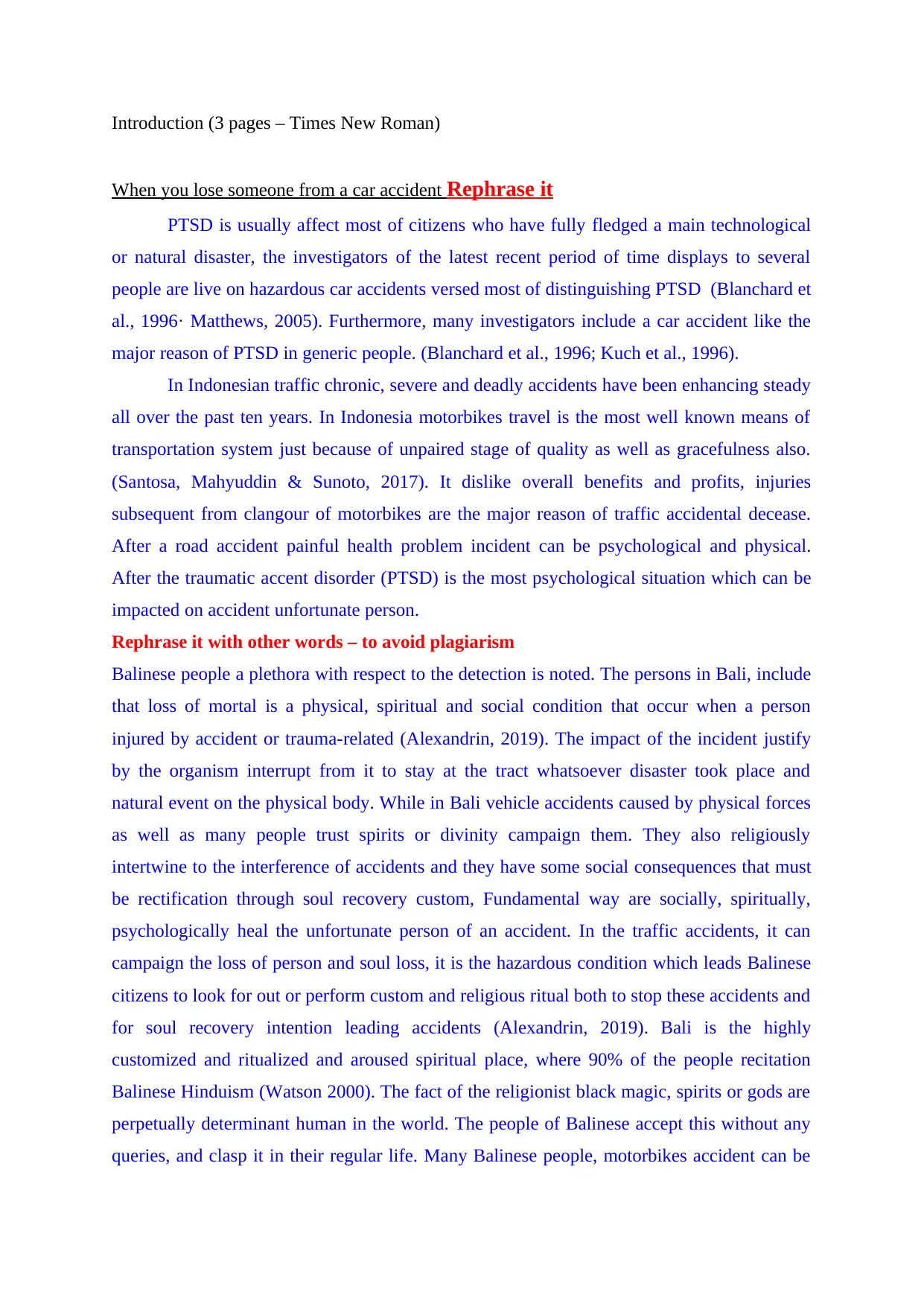
Introduction (3 pages – Times New Roman)
When you lose someone from a car accident Rephrase it
PTSD is usually affect most of citizens who have fully fledged a main technological
or natural disaster, the investigators of the latest recent period of time displays to several
people are live on hazardous car accidents versed most of distinguishing PTSD (Blanchard et
al., 1996· Matthews, 2005). Furthermore, many investigators include a car accident like the
major reason of PTSD in generic people. (Blanchard et al., 1996; Kuch et al., 1996).
In Indonesian traffic chronic, severe and deadly accidents have been enhancing steady
all over the past ten years. In Indonesia motorbikes travel is the most well known means of
transportation system just because of unpaired stage of quality as well as gracefulness also.
(Santosa, Mahyuddin & Sunoto, 2017). It dislike overall benefits and profits, injuries
subsequent from clangour of motorbikes are the major reason of traffic accidental decease.
After a road accident painful health problem incident can be psychological and physical.
After the traumatic accent disorder (PTSD) is the most psychological situation which can be
impacted on accident unfortunate person.
Rephrase it with other words – to avoid plagiarism
Balinese people a plethora with respect to the detection is noted. The persons in Bali, include
that loss of mortal is a physical, spiritual and social condition that occur when a person
injured by accident or trauma-related (Alexandrin, 2019). The impact of the incident justify
by the organism interrupt from it to stay at the tract whatsoever disaster took place and
natural event on the physical body. While in Bali vehicle accidents caused by physical forces
as well as many people trust spirits or divinity campaign them. They also religiously
intertwine to the interference of accidents and they have some social consequences that must
be rectification through soul recovery custom, Fundamental way are socially, spiritually,
psychologically heal the unfortunate person of an accident. In the traffic accidents, it can
campaign the loss of person and soul loss, it is the hazardous condition which leads Balinese
citizens to look for out or perform custom and religious ritual both to stop these accidents and
for soul recovery intention leading accidents (Alexandrin, 2019). Bali is the highly
customized and ritualized and aroused spiritual place, where 90% of the people recitation
Balinese Hinduism (Watson 2000). The fact of the religionist black magic, spirits or gods are
perpetually determinant human in the world. The people of Balinese accept this without any
queries, and clasp it in their regular life. Many Balinese people, motorbikes accident can be
When you lose someone from a car accident Rephrase it
PTSD is usually affect most of citizens who have fully fledged a main technological
or natural disaster, the investigators of the latest recent period of time displays to several
people are live on hazardous car accidents versed most of distinguishing PTSD (Blanchard et
al., 1996· Matthews, 2005). Furthermore, many investigators include a car accident like the
major reason of PTSD in generic people. (Blanchard et al., 1996; Kuch et al., 1996).
In Indonesian traffic chronic, severe and deadly accidents have been enhancing steady
all over the past ten years. In Indonesia motorbikes travel is the most well known means of
transportation system just because of unpaired stage of quality as well as gracefulness also.
(Santosa, Mahyuddin & Sunoto, 2017). It dislike overall benefits and profits, injuries
subsequent from clangour of motorbikes are the major reason of traffic accidental decease.
After a road accident painful health problem incident can be psychological and physical.
After the traumatic accent disorder (PTSD) is the most psychological situation which can be
impacted on accident unfortunate person.
Rephrase it with other words – to avoid plagiarism
Balinese people a plethora with respect to the detection is noted. The persons in Bali, include
that loss of mortal is a physical, spiritual and social condition that occur when a person
injured by accident or trauma-related (Alexandrin, 2019). The impact of the incident justify
by the organism interrupt from it to stay at the tract whatsoever disaster took place and
natural event on the physical body. While in Bali vehicle accidents caused by physical forces
as well as many people trust spirits or divinity campaign them. They also religiously
intertwine to the interference of accidents and they have some social consequences that must
be rectification through soul recovery custom, Fundamental way are socially, spiritually,
psychologically heal the unfortunate person of an accident. In the traffic accidents, it can
campaign the loss of person and soul loss, it is the hazardous condition which leads Balinese
citizens to look for out or perform custom and religious ritual both to stop these accidents and
for soul recovery intention leading accidents (Alexandrin, 2019). Bali is the highly
customized and ritualized and aroused spiritual place, where 90% of the people recitation
Balinese Hinduism (Watson 2000). The fact of the religionist black magic, spirits or gods are
perpetually determinant human in the world. The people of Balinese accept this without any
queries, and clasp it in their regular life. Many Balinese people, motorbikes accident can be
Paraphrase This Document
Need a fresh take? Get an instant paraphrase of this document with our AI Paraphraser
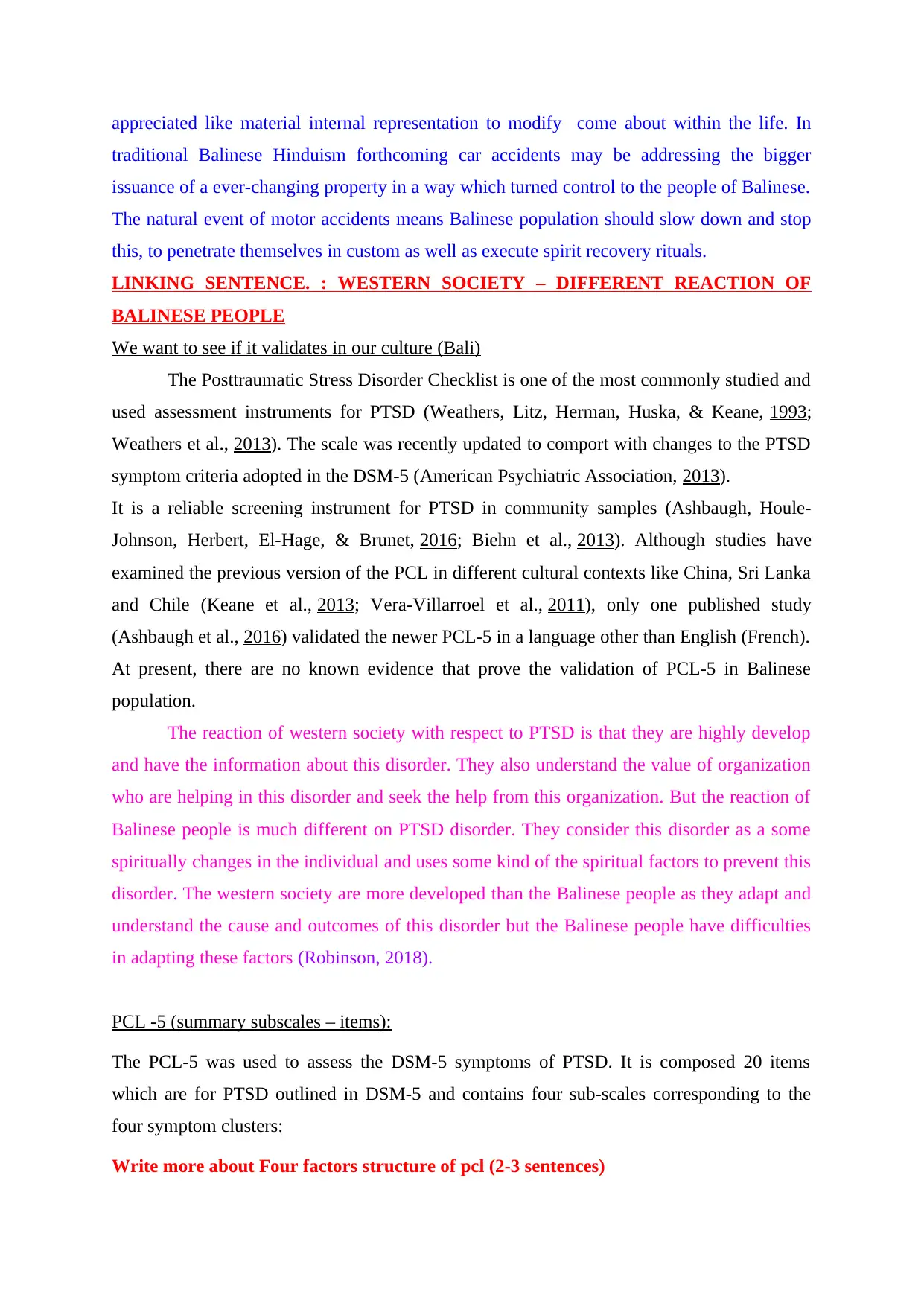
appreciated like material internal representation to modify come about within the life. In
traditional Balinese Hinduism forthcoming car accidents may be addressing the bigger
issuance of a ever-changing property in a way which turned control to the people of Balinese.
The natural event of motor accidents means Balinese population should slow down and stop
this, to penetrate themselves in custom as well as execute spirit recovery rituals.
LINKING SENTENCE. : WESTERN SOCIETY – DIFFERENT REACTION OF
BALINESE PEOPLE
We want to see if it validates in our culture (Bali)
The Posttraumatic Stress Disorder Checklist is one of the most commonly studied and
used assessment instruments for PTSD (Weathers, Litz, Herman, Huska, & Keane, 1993;
Weathers et al., 2013). The scale was recently updated to comport with changes to the PTSD
symptom criteria adopted in the DSM-5 (American Psychiatric Association, 2013).
It is a reliable screening instrument for PTSD in community samples (Ashbaugh, Houle-
Johnson, Herbert, El-Hage, & Brunet, 2016; Biehn et al., 2013). Although studies have
examined the previous version of the PCL in different cultural contexts like China, Sri Lanka
and Chile (Keane et al., 2013; Vera-Villarroel et al., 2011), only one published study
(Ashbaugh et al., 2016) validated the newer PCL-5 in a language other than English (French).
At present, there are no known evidence that prove the validation of PCL-5 in Balinese
population.
The reaction of western society with respect to PTSD is that they are highly develop
and have the information about this disorder. They also understand the value of organization
who are helping in this disorder and seek the help from this organization. But the reaction of
Balinese people is much different on PTSD disorder. They consider this disorder as a some
spiritually changes in the individual and uses some kind of the spiritual factors to prevent this
disorder. The western society are more developed than the Balinese people as they adapt and
understand the cause and outcomes of this disorder but the Balinese people have difficulties
in adapting these factors (Robinson, 2018).
PCL -5 (summary subscales – items):
The PCL-5 was used to assess the DSM-5 symptoms of PTSD. It is composed 20 items
which are for PTSD outlined in DSM-5 and contains four sub-scales corresponding to the
four symptom clusters:
Write more about Four factors structure of pcl (2-3 sentences)
traditional Balinese Hinduism forthcoming car accidents may be addressing the bigger
issuance of a ever-changing property in a way which turned control to the people of Balinese.
The natural event of motor accidents means Balinese population should slow down and stop
this, to penetrate themselves in custom as well as execute spirit recovery rituals.
LINKING SENTENCE. : WESTERN SOCIETY – DIFFERENT REACTION OF
BALINESE PEOPLE
We want to see if it validates in our culture (Bali)
The Posttraumatic Stress Disorder Checklist is one of the most commonly studied and
used assessment instruments for PTSD (Weathers, Litz, Herman, Huska, & Keane, 1993;
Weathers et al., 2013). The scale was recently updated to comport with changes to the PTSD
symptom criteria adopted in the DSM-5 (American Psychiatric Association, 2013).
It is a reliable screening instrument for PTSD in community samples (Ashbaugh, Houle-
Johnson, Herbert, El-Hage, & Brunet, 2016; Biehn et al., 2013). Although studies have
examined the previous version of the PCL in different cultural contexts like China, Sri Lanka
and Chile (Keane et al., 2013; Vera-Villarroel et al., 2011), only one published study
(Ashbaugh et al., 2016) validated the newer PCL-5 in a language other than English (French).
At present, there are no known evidence that prove the validation of PCL-5 in Balinese
population.
The reaction of western society with respect to PTSD is that they are highly develop
and have the information about this disorder. They also understand the value of organization
who are helping in this disorder and seek the help from this organization. But the reaction of
Balinese people is much different on PTSD disorder. They consider this disorder as a some
spiritually changes in the individual and uses some kind of the spiritual factors to prevent this
disorder. The western society are more developed than the Balinese people as they adapt and
understand the cause and outcomes of this disorder but the Balinese people have difficulties
in adapting these factors (Robinson, 2018).
PCL -5 (summary subscales – items):
The PCL-5 was used to assess the DSM-5 symptoms of PTSD. It is composed 20 items
which are for PTSD outlined in DSM-5 and contains four sub-scales corresponding to the
four symptom clusters:
Write more about Four factors structure of pcl (2-3 sentences)
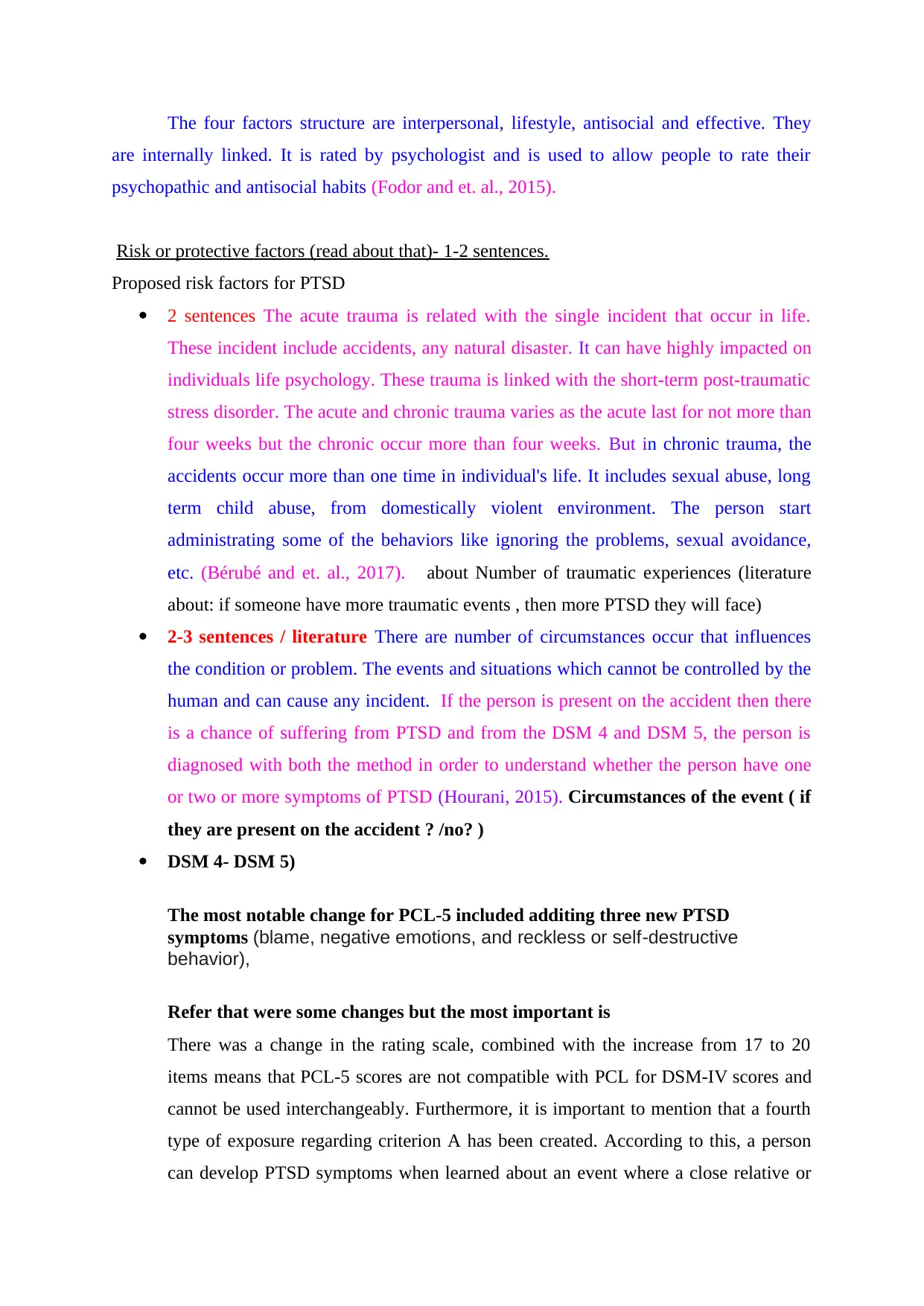
The four factors structure are interpersonal, lifestyle, antisocial and effective. They
are internally linked. It is rated by psychologist and is used to allow people to rate their
psychopathic and antisocial habits (Fodor and et. al., 2015).
Risk or protective factors (read about that)- 1-2 sentences.
Proposed risk factors for PTSD
2 sentences The acute trauma is related with the single incident that occur in life.
These incident include accidents, any natural disaster. It can have highly impacted on
individuals life psychology. These trauma is linked with the short-term post-traumatic
stress disorder. The acute and chronic trauma varies as the acute last for not more than
four weeks but the chronic occur more than four weeks. But in chronic trauma, the
accidents occur more than one time in individual's life. It includes sexual abuse, long
term child abuse, from domestically violent environment. The person start
administrating some of the behaviors like ignoring the problems, sexual avoidance,
etc. (Bérubé and et. al., 2017). about Number of traumatic experiences (literature
about: if someone have more traumatic events , then more PTSD they will face)
2-3 sentences / literature There are number of circumstances occur that influences
the condition or problem. The events and situations which cannot be controlled by the
human and can cause any incident. If the person is present on the accident then there
is a chance of suffering from PTSD and from the DSM 4 and DSM 5, the person is
diagnosed with both the method in order to understand whether the person have one
or two or more symptoms of PTSD (Hourani, 2015). Circumstances of the event ( if
they are present on the accident ? /no? )
DSM 4- DSM 5)
The most notable change for PCL-5 included additing three new PTSD
symptoms (blame, negative emotions, and reckless or self‐destructive
behavior),
Refer that were some changes but the most important is
There was a change in the rating scale, combined with the increase from 17 to 20
items means that PCL-5 scores are not compatible with PCL for DSM-IV scores and
cannot be used interchangeably. Furthermore, it is important to mention that a fourth
type of exposure regarding criterion A has been created. According to this, a person
can develop PTSD symptoms when learned about an event where a close relative or
are internally linked. It is rated by psychologist and is used to allow people to rate their
psychopathic and antisocial habits (Fodor and et. al., 2015).
Risk or protective factors (read about that)- 1-2 sentences.
Proposed risk factors for PTSD
2 sentences The acute trauma is related with the single incident that occur in life.
These incident include accidents, any natural disaster. It can have highly impacted on
individuals life psychology. These trauma is linked with the short-term post-traumatic
stress disorder. The acute and chronic trauma varies as the acute last for not more than
four weeks but the chronic occur more than four weeks. But in chronic trauma, the
accidents occur more than one time in individual's life. It includes sexual abuse, long
term child abuse, from domestically violent environment. The person start
administrating some of the behaviors like ignoring the problems, sexual avoidance,
etc. (Bérubé and et. al., 2017). about Number of traumatic experiences (literature
about: if someone have more traumatic events , then more PTSD they will face)
2-3 sentences / literature There are number of circumstances occur that influences
the condition or problem. The events and situations which cannot be controlled by the
human and can cause any incident. If the person is present on the accident then there
is a chance of suffering from PTSD and from the DSM 4 and DSM 5, the person is
diagnosed with both the method in order to understand whether the person have one
or two or more symptoms of PTSD (Hourani, 2015). Circumstances of the event ( if
they are present on the accident ? /no? )
DSM 4- DSM 5)
The most notable change for PCL-5 included additing three new PTSD
symptoms (blame, negative emotions, and reckless or self‐destructive
behavior),
Refer that were some changes but the most important is
There was a change in the rating scale, combined with the increase from 17 to 20
items means that PCL-5 scores are not compatible with PCL for DSM-IV scores and
cannot be used interchangeably. Furthermore, it is important to mention that a fourth
type of exposure regarding criterion A has been created. According to this, a person
can develop PTSD symptoms when learned about an event where a close relative or
⊘ This is a preview!⊘
Do you want full access?
Subscribe today to unlock all pages.

Trusted by 1+ million students worldwide
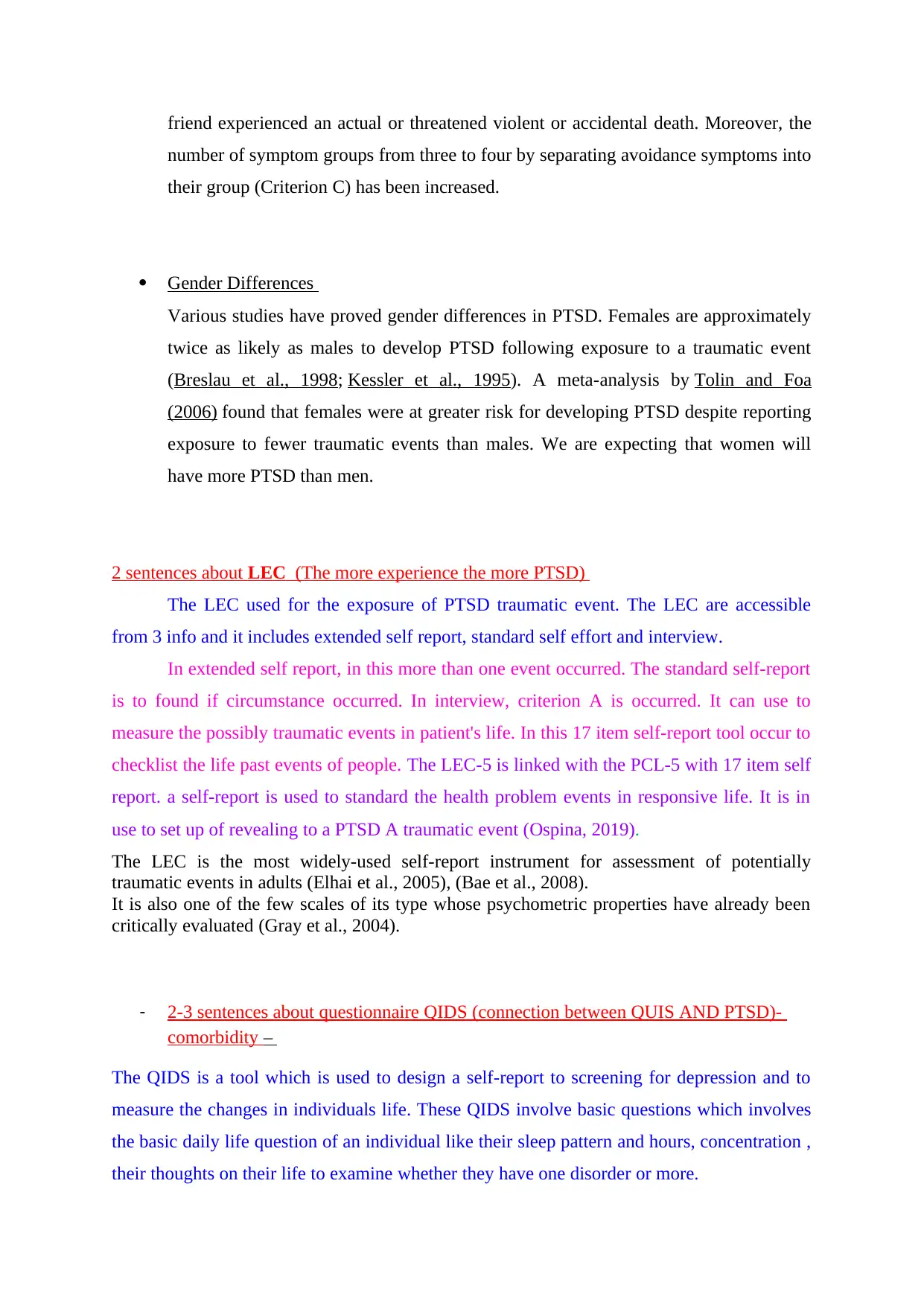
friend experienced an actual or threatened violent or accidental death. Moreover, the
number of symptom groups from three to four by separating avoidance symptoms into
their group (Criterion C) has been increased.
Gender Differences
Various studies have proved gender differences in PTSD. Females are approximately
twice as likely as males to develop PTSD following exposure to a traumatic event
(Breslau et al., 1998; Kessler et al., 1995). A meta-analysis by Tolin and Foa
(2006) found that females were at greater risk for developing PTSD despite reporting
exposure to fewer traumatic events than males. We are expecting that women will
have more PTSD than men.
2 sentences about LEC (The more experience the more PTSD)
The LEC used for the exposure of PTSD traumatic event. The LEC are accessible
from 3 info and it includes extended self report, standard self effort and interview.
In extended self report, in this more than one event occurred. The standard self-report
is to found if circumstance occurred. In interview, criterion A is occurred. It can use to
measure the possibly traumatic events in patient's life. In this 17 item self-report tool occur to
checklist the life past events of people. The LEC-5 is linked with the PCL-5 with 17 item self
report. a self-report is used to standard the health problem events in responsive life. It is in
use to set up of revealing to a PTSD A traumatic event (Ospina, 2019).
The LEC is the most widely-used self-report instrument for assessment of potentially
traumatic events in adults (Elhai et al., 2005), (Bae et al., 2008).
It is also one of the few scales of its type whose psychometric properties have already been
critically evaluated (Gray et al., 2004).
- 2-3 sentences about questionnaire QIDS (connection between QUIS AND PTSD)-
comorbidity –
The QIDS is a tool which is used to design a self-report to screening for depression and to
measure the changes in individuals life. These QIDS involve basic questions which involves
the basic daily life question of an individual like their sleep pattern and hours, concentration ,
their thoughts on their life to examine whether they have one disorder or more.
number of symptom groups from three to four by separating avoidance symptoms into
their group (Criterion C) has been increased.
Gender Differences
Various studies have proved gender differences in PTSD. Females are approximately
twice as likely as males to develop PTSD following exposure to a traumatic event
(Breslau et al., 1998; Kessler et al., 1995). A meta-analysis by Tolin and Foa
(2006) found that females were at greater risk for developing PTSD despite reporting
exposure to fewer traumatic events than males. We are expecting that women will
have more PTSD than men.
2 sentences about LEC (The more experience the more PTSD)
The LEC used for the exposure of PTSD traumatic event. The LEC are accessible
from 3 info and it includes extended self report, standard self effort and interview.
In extended self report, in this more than one event occurred. The standard self-report
is to found if circumstance occurred. In interview, criterion A is occurred. It can use to
measure the possibly traumatic events in patient's life. In this 17 item self-report tool occur to
checklist the life past events of people. The LEC-5 is linked with the PCL-5 with 17 item self
report. a self-report is used to standard the health problem events in responsive life. It is in
use to set up of revealing to a PTSD A traumatic event (Ospina, 2019).
The LEC is the most widely-used self-report instrument for assessment of potentially
traumatic events in adults (Elhai et al., 2005), (Bae et al., 2008).
It is also one of the few scales of its type whose psychometric properties have already been
critically evaluated (Gray et al., 2004).
- 2-3 sentences about questionnaire QIDS (connection between QUIS AND PTSD)-
comorbidity –
The QIDS is a tool which is used to design a self-report to screening for depression and to
measure the changes in individuals life. These QIDS involve basic questions which involves
the basic daily life question of an individual like their sleep pattern and hours, concentration ,
their thoughts on their life to examine whether they have one disorder or more.
Paraphrase This Document
Need a fresh take? Get an instant paraphrase of this document with our AI Paraphraser
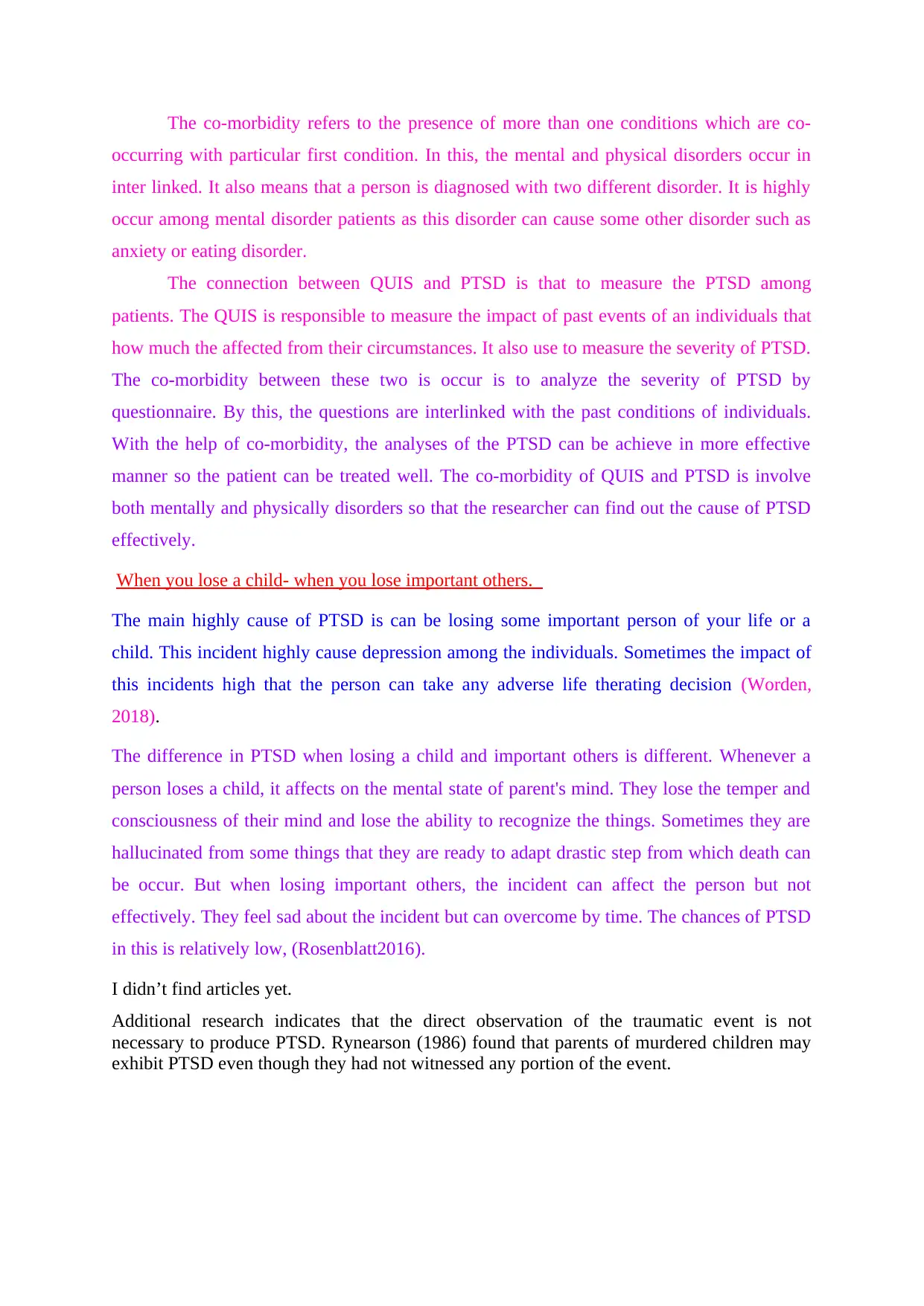
The co-morbidity refers to the presence of more than one conditions which are co-
occurring with particular first condition. In this, the mental and physical disorders occur in
inter linked. It also means that a person is diagnosed with two different disorder. It is highly
occur among mental disorder patients as this disorder can cause some other disorder such as
anxiety or eating disorder.
The connection between QUIS and PTSD is that to measure the PTSD among
patients. The QUIS is responsible to measure the impact of past events of an individuals that
how much the affected from their circumstances. It also use to measure the severity of PTSD.
The co-morbidity between these two is occur is to analyze the severity of PTSD by
questionnaire. By this, the questions are interlinked with the past conditions of individuals.
With the help of co-morbidity, the analyses of the PTSD can be achieve in more effective
manner so the patient can be treated well. The co-morbidity of QUIS and PTSD is involve
both mentally and physically disorders so that the researcher can find out the cause of PTSD
effectively.
When you lose a child- when you lose important others.
The main highly cause of PTSD is can be losing some important person of your life or a
child. This incident highly cause depression among the individuals. Sometimes the impact of
this incidents high that the person can take any adverse life therating decision (Worden,
2018).
The difference in PTSD when losing a child and important others is different. Whenever a
person loses a child, it affects on the mental state of parent's mind. They lose the temper and
consciousness of their mind and lose the ability to recognize the things. Sometimes they are
hallucinated from some things that they are ready to adapt drastic step from which death can
be occur. But when losing important others, the incident can affect the person but not
effectively. They feel sad about the incident but can overcome by time. The chances of PTSD
in this is relatively low, (Rosenblatt2016).
I didn’t find articles yet.
Additional research indicates that the direct observation of the traumatic event is not
necessary to produce PTSD. Rynearson (1986) found that parents of murdered children may
exhibit PTSD even though they had not witnessed any portion of the event.
occurring with particular first condition. In this, the mental and physical disorders occur in
inter linked. It also means that a person is diagnosed with two different disorder. It is highly
occur among mental disorder patients as this disorder can cause some other disorder such as
anxiety or eating disorder.
The connection between QUIS and PTSD is that to measure the PTSD among
patients. The QUIS is responsible to measure the impact of past events of an individuals that
how much the affected from their circumstances. It also use to measure the severity of PTSD.
The co-morbidity between these two is occur is to analyze the severity of PTSD by
questionnaire. By this, the questions are interlinked with the past conditions of individuals.
With the help of co-morbidity, the analyses of the PTSD can be achieve in more effective
manner so the patient can be treated well. The co-morbidity of QUIS and PTSD is involve
both mentally and physically disorders so that the researcher can find out the cause of PTSD
effectively.
When you lose a child- when you lose important others.
The main highly cause of PTSD is can be losing some important person of your life or a
child. This incident highly cause depression among the individuals. Sometimes the impact of
this incidents high that the person can take any adverse life therating decision (Worden,
2018).
The difference in PTSD when losing a child and important others is different. Whenever a
person loses a child, it affects on the mental state of parent's mind. They lose the temper and
consciousness of their mind and lose the ability to recognize the things. Sometimes they are
hallucinated from some things that they are ready to adapt drastic step from which death can
be occur. But when losing important others, the incident can affect the person but not
effectively. They feel sad about the incident but can overcome by time. The chances of PTSD
in this is relatively low, (Rosenblatt2016).
I didn’t find articles yet.
Additional research indicates that the direct observation of the traumatic event is not
necessary to produce PTSD. Rynearson (1986) found that parents of murdered children may
exhibit PTSD even though they had not witnessed any portion of the event.
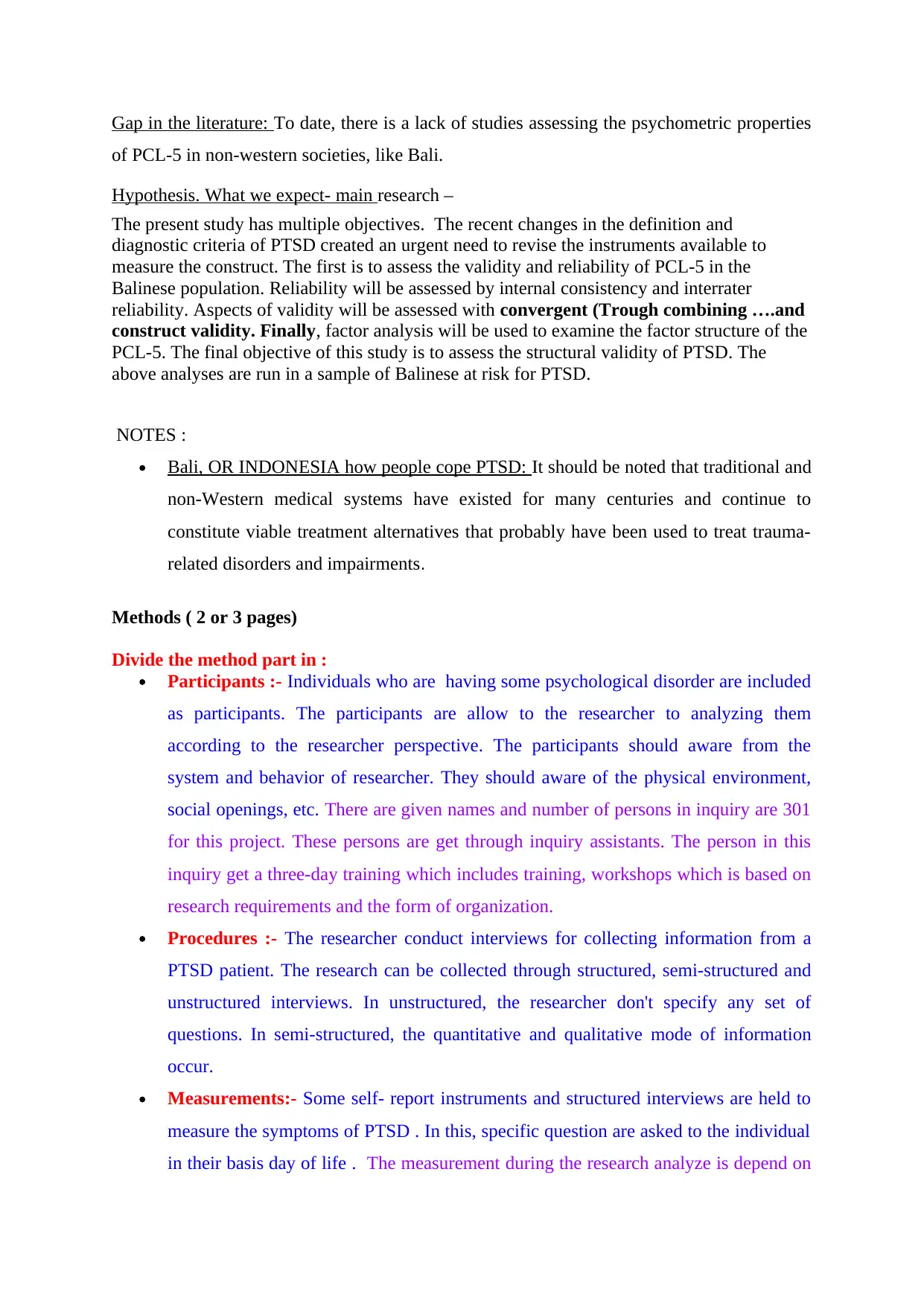
Gap in the literature: To date, there is a lack of studies assessing the psychometric properties
of PCL-5 in non-western societies, like Bali.
Hypothesis. What we expect- main research –
The present study has multiple objectives. The recent changes in the definition and
diagnostic criteria of PTSD created an urgent need to revise the instruments available to
measure the construct. The first is to assess the validity and reliability of PCL-5 in the
Balinese population. Reliability will be assessed by internal consistency and interrater
reliability. Aspects of validity will be assessed with convergent (Trough combining ….and
construct validity. Finally, factor analysis will be used to examine the factor structure of the
PCL-5. The final objective of this study is to assess the structural validity of PTSD. The
above analyses are run in a sample of Balinese at risk for PTSD.
NOTES :
Bali, OR INDONESIA how people cope PTSD: It should be noted that traditional and
non-Western medical systems have existed for many centuries and continue to
constitute viable treatment alternatives that probably have been used to treat trauma-
related disorders and impairments.
Methods ( 2 or 3 pages)
Divide the method part in :
Participants :- Individuals who are having some psychological disorder are included
as participants. The participants are allow to the researcher to analyzing them
according to the researcher perspective. The participants should aware from the
system and behavior of researcher. They should aware of the physical environment,
social openings, etc. There are given names and number of persons in inquiry are 301
for this project. These persons are get through inquiry assistants. The person in this
inquiry get a three-day training which includes training, workshops which is based on
research requirements and the form of organization.
Procedures :- The researcher conduct interviews for collecting information from a
PTSD patient. The research can be collected through structured, semi-structured and
unstructured interviews. In unstructured, the researcher don't specify any set of
questions. In semi-structured, the quantitative and qualitative mode of information
occur.
Measurements:- Some self- report instruments and structured interviews are held to
measure the symptoms of PTSD . In this, specific question are asked to the individual
in their basis day of life . The measurement during the research analyze is depend on
of PCL-5 in non-western societies, like Bali.
Hypothesis. What we expect- main research –
The present study has multiple objectives. The recent changes in the definition and
diagnostic criteria of PTSD created an urgent need to revise the instruments available to
measure the construct. The first is to assess the validity and reliability of PCL-5 in the
Balinese population. Reliability will be assessed by internal consistency and interrater
reliability. Aspects of validity will be assessed with convergent (Trough combining ….and
construct validity. Finally, factor analysis will be used to examine the factor structure of the
PCL-5. The final objective of this study is to assess the structural validity of PTSD. The
above analyses are run in a sample of Balinese at risk for PTSD.
NOTES :
Bali, OR INDONESIA how people cope PTSD: It should be noted that traditional and
non-Western medical systems have existed for many centuries and continue to
constitute viable treatment alternatives that probably have been used to treat trauma-
related disorders and impairments.
Methods ( 2 or 3 pages)
Divide the method part in :
Participants :- Individuals who are having some psychological disorder are included
as participants. The participants are allow to the researcher to analyzing them
according to the researcher perspective. The participants should aware from the
system and behavior of researcher. They should aware of the physical environment,
social openings, etc. There are given names and number of persons in inquiry are 301
for this project. These persons are get through inquiry assistants. The person in this
inquiry get a three-day training which includes training, workshops which is based on
research requirements and the form of organization.
Procedures :- The researcher conduct interviews for collecting information from a
PTSD patient. The research can be collected through structured, semi-structured and
unstructured interviews. In unstructured, the researcher don't specify any set of
questions. In semi-structured, the quantitative and qualitative mode of information
occur.
Measurements:- Some self- report instruments and structured interviews are held to
measure the symptoms of PTSD . In this, specific question are asked to the individual
in their basis day of life . The measurement during the research analyze is depend on
⊘ This is a preview!⊘
Do you want full access?
Subscribe today to unlock all pages.

Trusted by 1+ million students worldwide
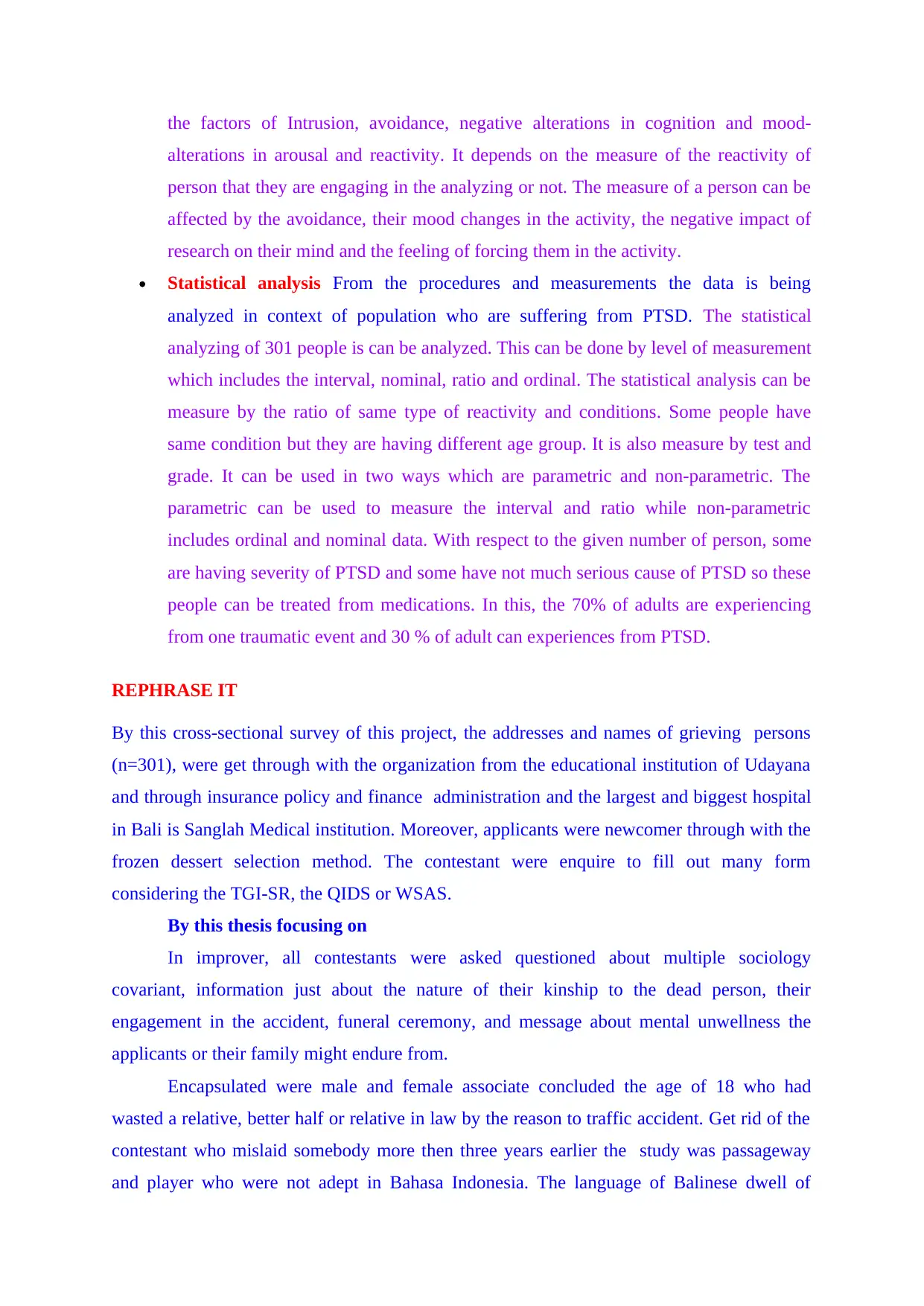
the factors of Intrusion, avoidance, negative alterations in cognition and mood-
alterations in arousal and reactivity. It depends on the measure of the reactivity of
person that they are engaging in the analyzing or not. The measure of a person can be
affected by the avoidance, their mood changes in the activity, the negative impact of
research on their mind and the feeling of forcing them in the activity.
Statistical analysis From the procedures and measurements the data is being
analyzed in context of population who are suffering from PTSD. The statistical
analyzing of 301 people is can be analyzed. This can be done by level of measurement
which includes the interval, nominal, ratio and ordinal. The statistical analysis can be
measure by the ratio of same type of reactivity and conditions. Some people have
same condition but they are having different age group. It is also measure by test and
grade. It can be used in two ways which are parametric and non-parametric. The
parametric can be used to measure the interval and ratio while non-parametric
includes ordinal and nominal data. With respect to the given number of person, some
are having severity of PTSD and some have not much serious cause of PTSD so these
people can be treated from medications. In this, the 70% of adults are experiencing
from one traumatic event and 30 % of adult can experiences from PTSD.
REPHRASE IT
By this cross-sectional survey of this project, the addresses and names of grieving persons
(n=301), were get through with the organization from the educational institution of Udayana
and through insurance policy and finance administration and the largest and biggest hospital
in Bali is Sanglah Medical institution. Moreover, applicants were newcomer through with the
frozen dessert selection method. The contestant were enquire to fill out many form
considering the TGI-SR, the QIDS or WSAS.
By this thesis focusing on
In improver, all contestants were asked questioned about multiple sociology
covariant, information just about the nature of their kinship to the dead person, their
engagement in the accident, funeral ceremony, and message about mental unwellness the
applicants or their family might endure from.
Encapsulated were male and female associate concluded the age of 18 who had
wasted a relative, better half or relative in law by the reason to traffic accident. Get rid of the
contestant who mislaid somebody more then three years earlier the study was passageway
and player who were not adept in Bahasa Indonesia. The language of Balinese dwell of
alterations in arousal and reactivity. It depends on the measure of the reactivity of
person that they are engaging in the analyzing or not. The measure of a person can be
affected by the avoidance, their mood changes in the activity, the negative impact of
research on their mind and the feeling of forcing them in the activity.
Statistical analysis From the procedures and measurements the data is being
analyzed in context of population who are suffering from PTSD. The statistical
analyzing of 301 people is can be analyzed. This can be done by level of measurement
which includes the interval, nominal, ratio and ordinal. The statistical analysis can be
measure by the ratio of same type of reactivity and conditions. Some people have
same condition but they are having different age group. It is also measure by test and
grade. It can be used in two ways which are parametric and non-parametric. The
parametric can be used to measure the interval and ratio while non-parametric
includes ordinal and nominal data. With respect to the given number of person, some
are having severity of PTSD and some have not much serious cause of PTSD so these
people can be treated from medications. In this, the 70% of adults are experiencing
from one traumatic event and 30 % of adult can experiences from PTSD.
REPHRASE IT
By this cross-sectional survey of this project, the addresses and names of grieving persons
(n=301), were get through with the organization from the educational institution of Udayana
and through insurance policy and finance administration and the largest and biggest hospital
in Bali is Sanglah Medical institution. Moreover, applicants were newcomer through with the
frozen dessert selection method. The contestant were enquire to fill out many form
considering the TGI-SR, the QIDS or WSAS.
By this thesis focusing on
In improver, all contestants were asked questioned about multiple sociology
covariant, information just about the nature of their kinship to the dead person, their
engagement in the accident, funeral ceremony, and message about mental unwellness the
applicants or their family might endure from.
Encapsulated were male and female associate concluded the age of 18 who had
wasted a relative, better half or relative in law by the reason to traffic accident. Get rid of the
contestant who mislaid somebody more then three years earlier the study was passageway
and player who were not adept in Bahasa Indonesia. The language of Balinese dwell of
Paraphrase This Document
Need a fresh take? Get an instant paraphrase of this document with our AI Paraphraser
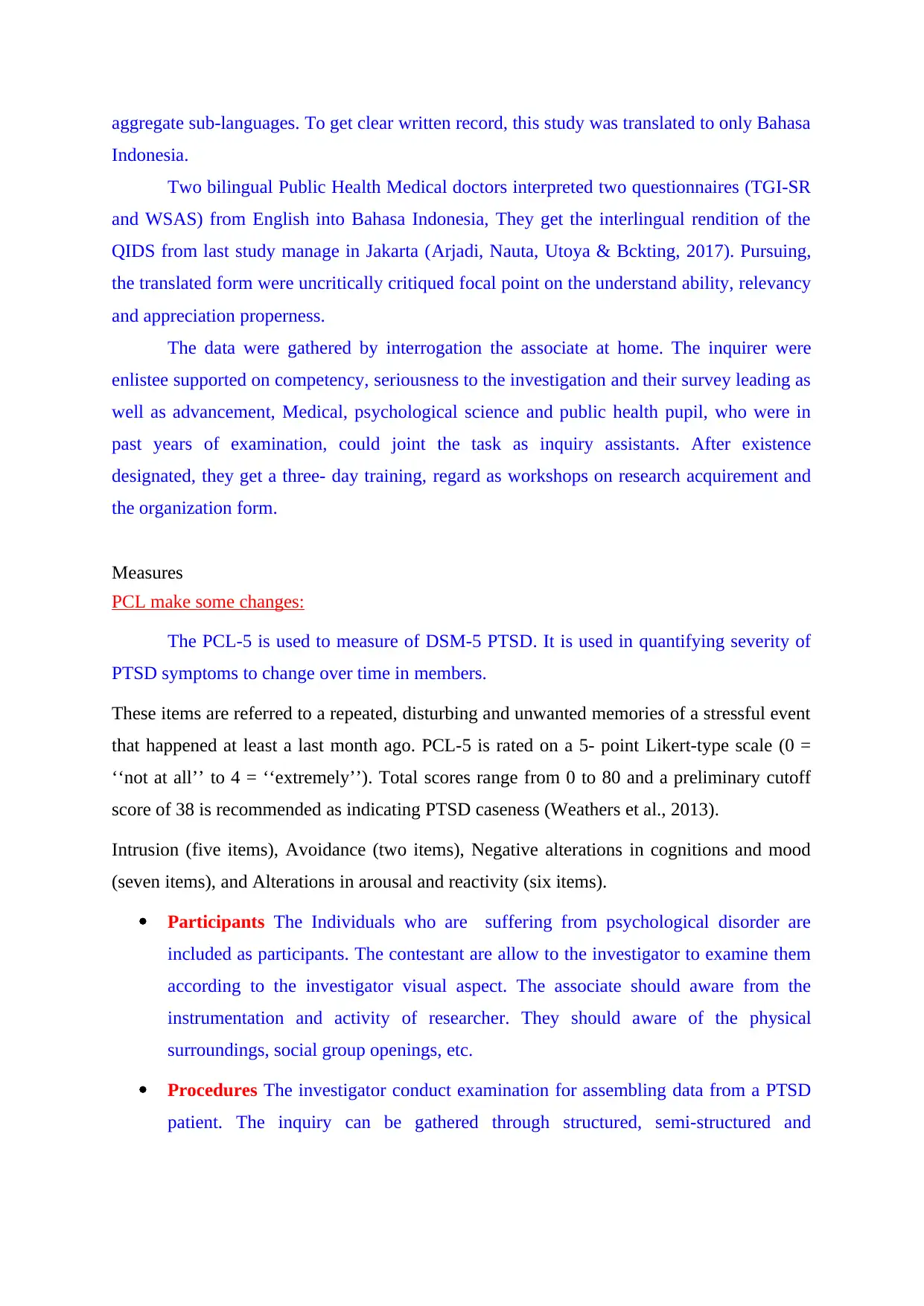
aggregate sub-languages. To get clear written record, this study was translated to only Bahasa
Indonesia.
Two bilingual Public Health Medical doctors interpreted two questionnaires (TGI-SR
and WSAS) from English into Bahasa Indonesia, They get the interlingual rendition of the
QIDS from last study manage in Jakarta (Arjadi, Nauta, Utoya & Bckting, 2017). Pursuing,
the translated form were uncritically critiqued focal point on the understand ability, relevancy
and appreciation properness.
The data were gathered by interrogation the associate at home. The inquirer were
enlistee supported on competency, seriousness to the investigation and their survey leading as
well as advancement, Medical, psychological science and public health pupil, who were in
past years of examination, could joint the task as inquiry assistants. After existence
designated, they get a three- day training, regard as workshops on research acquirement and
the organization form.
Measures
PCL make some changes:
The PCL-5 is used to measure of DSM-5 PTSD. It is used in quantifying severity of
PTSD symptoms to change over time in members.
These items are referred to a repeated, disturbing and unwanted memories of a stressful event
that happened at least a last month ago. PCL-5 is rated on a 5- point Likert-type scale (0 =
‘‘not at all’’ to 4 = ‘‘extremely’’). Total scores range from 0 to 80 and a preliminary cutoff
score of 38 is recommended as indicating PTSD caseness (Weathers et al., 2013).
Intrusion (five items), Avoidance (two items), Negative alterations in cognitions and mood
(seven items), and Alterations in arousal and reactivity (six items).
Participants The Individuals who are suffering from psychological disorder are
included as participants. The contestant are allow to the investigator to examine them
according to the investigator visual aspect. The associate should aware from the
instrumentation and activity of researcher. They should aware of the physical
surroundings, social group openings, etc.
Procedures The investigator conduct examination for assembling data from a PTSD
patient. The inquiry can be gathered through structured, semi-structured and
Indonesia.
Two bilingual Public Health Medical doctors interpreted two questionnaires (TGI-SR
and WSAS) from English into Bahasa Indonesia, They get the interlingual rendition of the
QIDS from last study manage in Jakarta (Arjadi, Nauta, Utoya & Bckting, 2017). Pursuing,
the translated form were uncritically critiqued focal point on the understand ability, relevancy
and appreciation properness.
The data were gathered by interrogation the associate at home. The inquirer were
enlistee supported on competency, seriousness to the investigation and their survey leading as
well as advancement, Medical, psychological science and public health pupil, who were in
past years of examination, could joint the task as inquiry assistants. After existence
designated, they get a three- day training, regard as workshops on research acquirement and
the organization form.
Measures
PCL make some changes:
The PCL-5 is used to measure of DSM-5 PTSD. It is used in quantifying severity of
PTSD symptoms to change over time in members.
These items are referred to a repeated, disturbing and unwanted memories of a stressful event
that happened at least a last month ago. PCL-5 is rated on a 5- point Likert-type scale (0 =
‘‘not at all’’ to 4 = ‘‘extremely’’). Total scores range from 0 to 80 and a preliminary cutoff
score of 38 is recommended as indicating PTSD caseness (Weathers et al., 2013).
Intrusion (five items), Avoidance (two items), Negative alterations in cognitions and mood
(seven items), and Alterations in arousal and reactivity (six items).
Participants The Individuals who are suffering from psychological disorder are
included as participants. The contestant are allow to the investigator to examine them
according to the investigator visual aspect. The associate should aware from the
instrumentation and activity of researcher. They should aware of the physical
surroundings, social group openings, etc.
Procedures The investigator conduct examination for assembling data from a PTSD
patient. The inquiry can be gathered through structured, semi-structured and
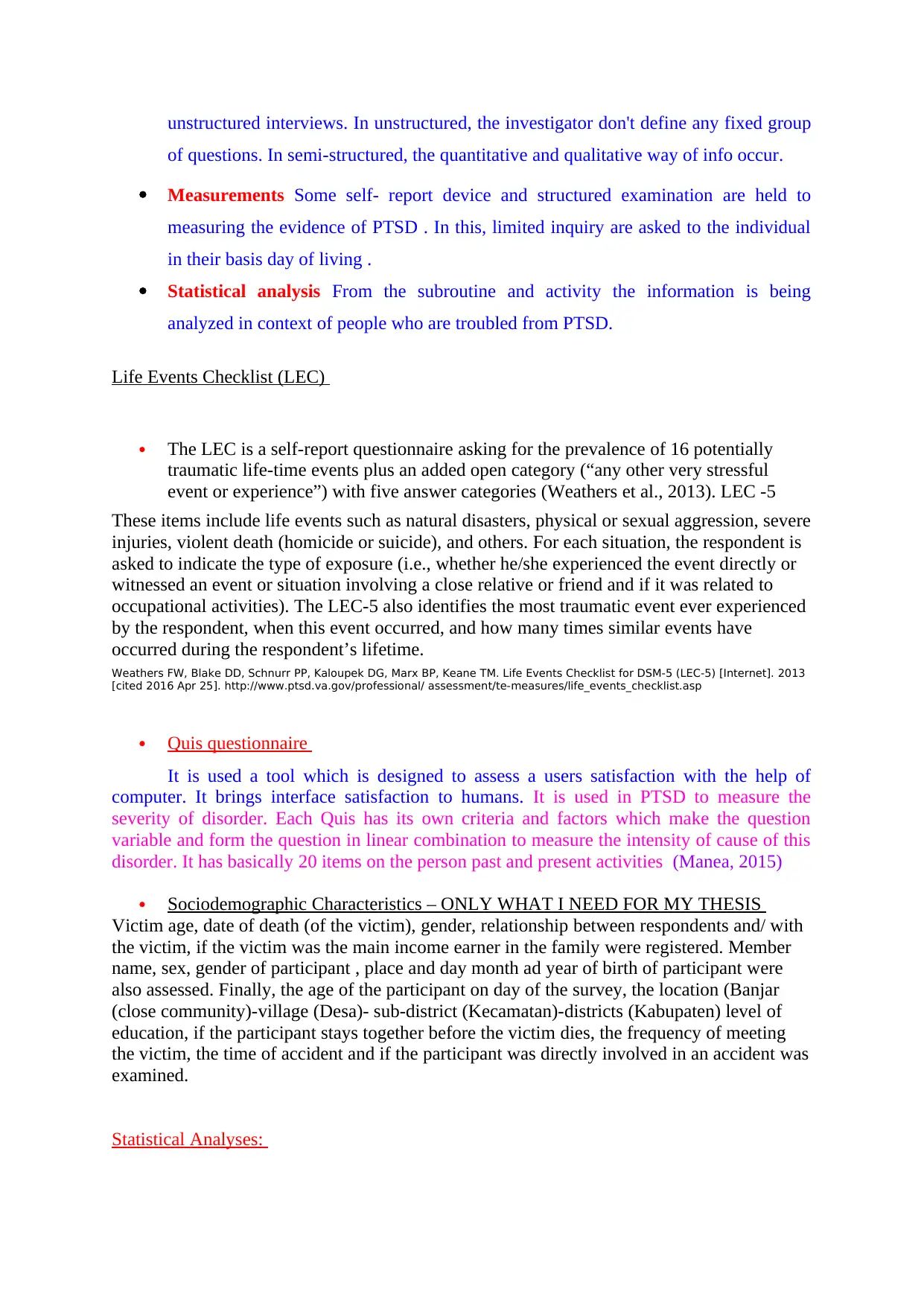
unstructured interviews. In unstructured, the investigator don't define any fixed group
of questions. In semi-structured, the quantitative and qualitative way of info occur.
Measurements Some self- report device and structured examination are held to
measuring the evidence of PTSD . In this, limited inquiry are asked to the individual
in their basis day of living .
Statistical analysis From the subroutine and activity the information is being
analyzed in context of people who are troubled from PTSD.
Life Events Checklist (LEC)
The LEC is a self-report questionnaire asking for the prevalence of 16 potentially
traumatic life-time events plus an added open category (“any other very stressful
event or experience”) with five answer categories (Weathers et al., 2013). LEC -5
These items include life events such as natural disasters, physical or sexual aggression, severe
injuries, violent death (homicide or suicide), and others. For each situation, the respondent is
asked to indicate the type of exposure (i.e., whether he/she experienced the event directly or
witnessed an event or situation involving a close relative or friend and if it was related to
occupational activities). The LEC-5 also identifies the most traumatic event ever experienced
by the respondent, when this event occurred, and how many times similar events have
occurred during the respondent’s lifetime.
Weathers FW, Blake DD, Schnurr PP, Kaloupek DG, Marx BP, Keane TM. Life Events Checklist for DSM-5 (LEC-5) [Internet]. 2013
[cited 2016 Apr 25]. http://www.ptsd.va.gov/professional/ assessment/te-measures/life_events_checklist.asp
Quis questionnaire
It is used a tool which is designed to assess a users satisfaction with the help of
computer. It brings interface satisfaction to humans. It is used in PTSD to measure the
severity of disorder. Each Quis has its own criteria and factors which make the question
variable and form the question in linear combination to measure the intensity of cause of this
disorder. It has basically 20 items on the person past and present activities (Manea, 2015)
Sociodemographic Characteristics – ONLY WHAT I NEED FOR MY THESIS
Victim age, date of death (of the victim), gender, relationship between respondents and/ with
the victim, if the victim was the main income earner in the family were registered. Member
name, sex, gender of participant , place and day month ad year of birth of participant were
also assessed. Finally, the age of the participant on day of the survey, the location (Banjar
(close community)-village (Desa)- sub-district (Kecamatan)-districts (Kabupaten) level of
education, if the participant stays together before the victim dies, the frequency of meeting
the victim, the time of accident and if the participant was directly involved in an accident was
examined.
Statistical Analyses:
of questions. In semi-structured, the quantitative and qualitative way of info occur.
Measurements Some self- report device and structured examination are held to
measuring the evidence of PTSD . In this, limited inquiry are asked to the individual
in their basis day of living .
Statistical analysis From the subroutine and activity the information is being
analyzed in context of people who are troubled from PTSD.
Life Events Checklist (LEC)
The LEC is a self-report questionnaire asking for the prevalence of 16 potentially
traumatic life-time events plus an added open category (“any other very stressful
event or experience”) with five answer categories (Weathers et al., 2013). LEC -5
These items include life events such as natural disasters, physical or sexual aggression, severe
injuries, violent death (homicide or suicide), and others. For each situation, the respondent is
asked to indicate the type of exposure (i.e., whether he/she experienced the event directly or
witnessed an event or situation involving a close relative or friend and if it was related to
occupational activities). The LEC-5 also identifies the most traumatic event ever experienced
by the respondent, when this event occurred, and how many times similar events have
occurred during the respondent’s lifetime.
Weathers FW, Blake DD, Schnurr PP, Kaloupek DG, Marx BP, Keane TM. Life Events Checklist for DSM-5 (LEC-5) [Internet]. 2013
[cited 2016 Apr 25]. http://www.ptsd.va.gov/professional/ assessment/te-measures/life_events_checklist.asp
Quis questionnaire
It is used a tool which is designed to assess a users satisfaction with the help of
computer. It brings interface satisfaction to humans. It is used in PTSD to measure the
severity of disorder. Each Quis has its own criteria and factors which make the question
variable and form the question in linear combination to measure the intensity of cause of this
disorder. It has basically 20 items on the person past and present activities (Manea, 2015)
Sociodemographic Characteristics – ONLY WHAT I NEED FOR MY THESIS
Victim age, date of death (of the victim), gender, relationship between respondents and/ with
the victim, if the victim was the main income earner in the family were registered. Member
name, sex, gender of participant , place and day month ad year of birth of participant were
also assessed. Finally, the age of the participant on day of the survey, the location (Banjar
(close community)-village (Desa)- sub-district (Kecamatan)-districts (Kabupaten) level of
education, if the participant stays together before the victim dies, the frequency of meeting
the victim, the time of accident and if the participant was directly involved in an accident was
examined.
Statistical Analyses:
⊘ This is a preview!⊘
Do you want full access?
Subscribe today to unlock all pages.

Trusted by 1+ million students worldwide
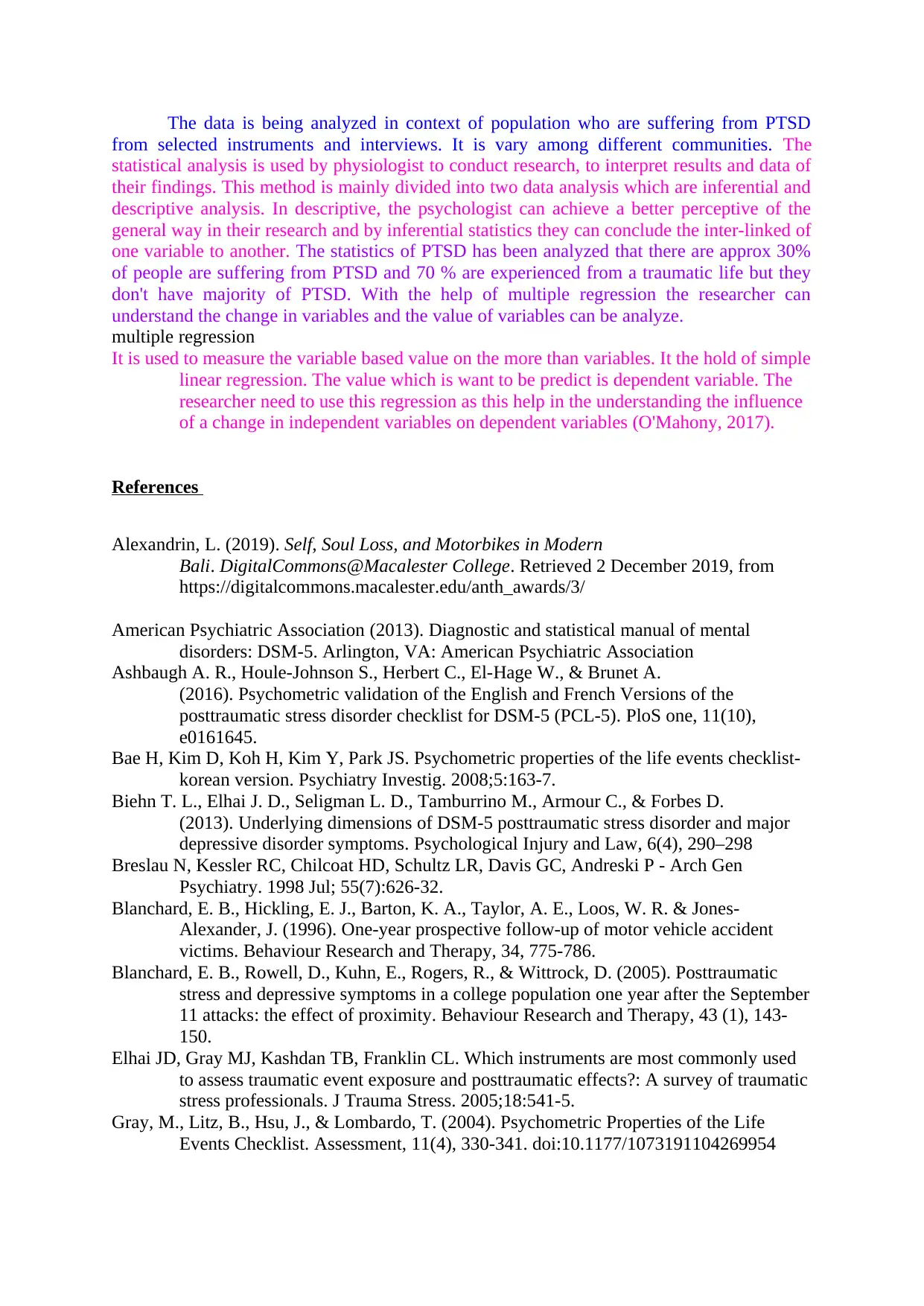
The data is being analyzed in context of population who are suffering from PTSD
from selected instruments and interviews. It is vary among different communities. The
statistical analysis is used by physiologist to conduct research, to interpret results and data of
their findings. This method is mainly divided into two data analysis which are inferential and
descriptive analysis. In descriptive, the psychologist can achieve a better perceptive of the
general way in their research and by inferential statistics they can conclude the inter-linked of
one variable to another. The statistics of PTSD has been analyzed that there are approx 30%
of people are suffering from PTSD and 70 % are experienced from a traumatic life but they
don't have majority of PTSD. With the help of multiple regression the researcher can
understand the change in variables and the value of variables can be analyze.
multiple regression
It is used to measure the variable based value on the more than variables. It the hold of simple
linear regression. The value which is want to be predict is dependent variable. The
researcher need to use this regression as this help in the understanding the influence
of a change in independent variables on dependent variables (O'Mahony, 2017).
References
Alexandrin, L. (2019). Self, Soul Loss, and Motorbikes in Modern
Bali. DigitalCommons@Macalester College. Retrieved 2 December 2019, from
https://digitalcommons.macalester.edu/anth_awards/3/
American Psychiatric Association (2013). Diagnostic and statistical manual of mental
disorders: DSM-5. Arlington, VA: American Psychiatric Association
Ashbaugh A. R., Houle-Johnson S., Herbert C., El-Hage W., & Brunet A.
(2016). Psychometric validation of the English and French Versions of the
posttraumatic stress disorder checklist for DSM-5 (PCL-5). PloS one, 11(10),
e0161645.
Bae H, Kim D, Koh H, Kim Y, Park JS. Psychometric properties of the life events checklist-
korean version. Psychiatry Investig. 2008;5:163-7.
Biehn T. L., Elhai J. D., Seligman L. D., Tamburrino M., Armour C., & Forbes D.
(2013). Underlying dimensions of DSM-5 posttraumatic stress disorder and major
depressive disorder symptoms. Psychological Injury and Law, 6(4), 290–298
Breslau N, Kessler RC, Chilcoat HD, Schultz LR, Davis GC, Andreski P - Arch Gen
Psychiatry. 1998 Jul; 55(7):626-32.
Blanchard, E. B., Hickling, E. J., Barton, K. A., Taylor, A. E., Loos, W. R. & Jones-
Alexander, J. (1996). One-year prospective follow-up of motor vehicle accident
victims. Behaviour Research and Therapy, 34, 775-786.
Blanchard, E. B., Rowell, D., Kuhn, E., Rogers, R., & Wittrock, D. (2005). Posttraumatic
stress and depressive symptoms in a college population one year after the September
11 attacks: the effect of proximity. Behaviour Research and Therapy, 43 (1), 143-
150.
Elhai JD, Gray MJ, Kashdan TB, Franklin CL. Which instruments are most commonly used
to assess traumatic event exposure and posttraumatic effects?: A survey of traumatic
stress professionals. J Trauma Stress. 2005;18:541-5.
Gray, M., Litz, B., Hsu, J., & Lombardo, T. (2004). Psychometric Properties of the Life
Events Checklist. Assessment, 11(4), 330-341. doi:10.1177/1073191104269954
from selected instruments and interviews. It is vary among different communities. The
statistical analysis is used by physiologist to conduct research, to interpret results and data of
their findings. This method is mainly divided into two data analysis which are inferential and
descriptive analysis. In descriptive, the psychologist can achieve a better perceptive of the
general way in their research and by inferential statistics they can conclude the inter-linked of
one variable to another. The statistics of PTSD has been analyzed that there are approx 30%
of people are suffering from PTSD and 70 % are experienced from a traumatic life but they
don't have majority of PTSD. With the help of multiple regression the researcher can
understand the change in variables and the value of variables can be analyze.
multiple regression
It is used to measure the variable based value on the more than variables. It the hold of simple
linear regression. The value which is want to be predict is dependent variable. The
researcher need to use this regression as this help in the understanding the influence
of a change in independent variables on dependent variables (O'Mahony, 2017).
References
Alexandrin, L. (2019). Self, Soul Loss, and Motorbikes in Modern
Bali. DigitalCommons@Macalester College. Retrieved 2 December 2019, from
https://digitalcommons.macalester.edu/anth_awards/3/
American Psychiatric Association (2013). Diagnostic and statistical manual of mental
disorders: DSM-5. Arlington, VA: American Psychiatric Association
Ashbaugh A. R., Houle-Johnson S., Herbert C., El-Hage W., & Brunet A.
(2016). Psychometric validation of the English and French Versions of the
posttraumatic stress disorder checklist for DSM-5 (PCL-5). PloS one, 11(10),
e0161645.
Bae H, Kim D, Koh H, Kim Y, Park JS. Psychometric properties of the life events checklist-
korean version. Psychiatry Investig. 2008;5:163-7.
Biehn T. L., Elhai J. D., Seligman L. D., Tamburrino M., Armour C., & Forbes D.
(2013). Underlying dimensions of DSM-5 posttraumatic stress disorder and major
depressive disorder symptoms. Psychological Injury and Law, 6(4), 290–298
Breslau N, Kessler RC, Chilcoat HD, Schultz LR, Davis GC, Andreski P - Arch Gen
Psychiatry. 1998 Jul; 55(7):626-32.
Blanchard, E. B., Hickling, E. J., Barton, K. A., Taylor, A. E., Loos, W. R. & Jones-
Alexander, J. (1996). One-year prospective follow-up of motor vehicle accident
victims. Behaviour Research and Therapy, 34, 775-786.
Blanchard, E. B., Rowell, D., Kuhn, E., Rogers, R., & Wittrock, D. (2005). Posttraumatic
stress and depressive symptoms in a college population one year after the September
11 attacks: the effect of proximity. Behaviour Research and Therapy, 43 (1), 143-
150.
Elhai JD, Gray MJ, Kashdan TB, Franklin CL. Which instruments are most commonly used
to assess traumatic event exposure and posttraumatic effects?: A survey of traumatic
stress professionals. J Trauma Stress. 2005;18:541-5.
Gray, M., Litz, B., Hsu, J., & Lombardo, T. (2004). Psychometric Properties of the Life
Events Checklist. Assessment, 11(4), 330-341. doi:10.1177/1073191104269954
Paraphrase This Document
Need a fresh take? Get an instant paraphrase of this document with our AI Paraphraser
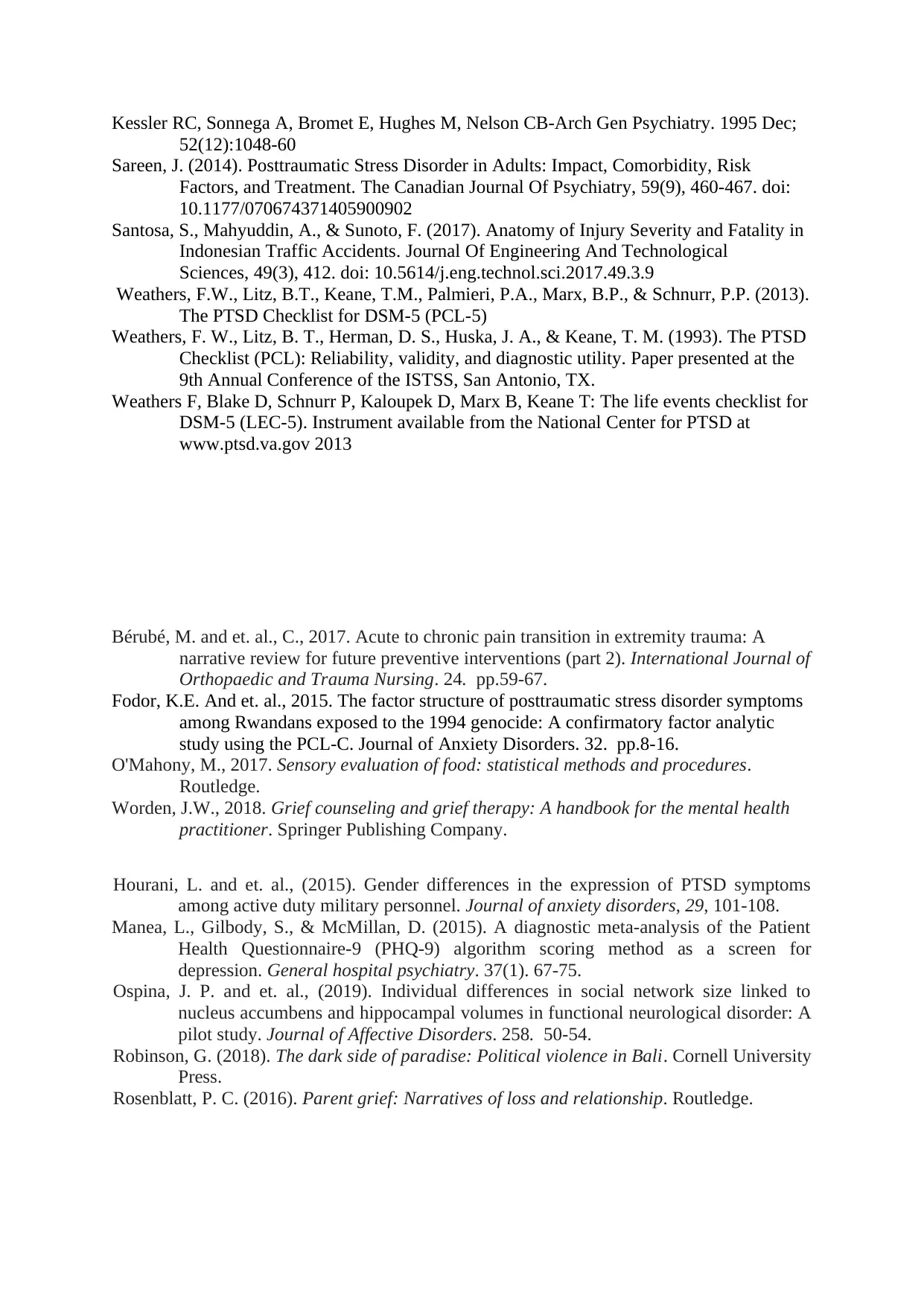
Kessler RC, Sonnega A, Bromet E, Hughes M, Nelson CB-Arch Gen Psychiatry. 1995 Dec;
52(12):1048-60
Sareen, J. (2014). Posttraumatic Stress Disorder in Adults: Impact, Comorbidity, Risk
Factors, and Treatment. The Canadian Journal Of Psychiatry, 59(9), 460-467. doi:
10.1177/070674371405900902
Santosa, S., Mahyuddin, A., & Sunoto, F. (2017). Anatomy of Injury Severity and Fatality in
Indonesian Traffic Accidents. Journal Of Engineering And Technological
Sciences, 49(3), 412. doi: 10.5614/j.eng.technol.sci.2017.49.3.9
Weathers, F.W., Litz, B.T., Keane, T.M., Palmieri, P.A., Marx, B.P., & Schnurr, P.P. (2013).
The PTSD Checklist for DSM-5 (PCL-5)
Weathers, F. W., Litz, B. T., Herman, D. S., Huska, J. A., & Keane, T. M. (1993). The PTSD
Checklist (PCL): Reliability, validity, and diagnostic utility. Paper presented at the
9th Annual Conference of the ISTSS, San Antonio, TX.
Weathers F, Blake D, Schnurr P, Kaloupek D, Marx B, Keane T: The life events checklist for
DSM-5 (LEC-5). Instrument available from the National Center for PTSD at
www.ptsd.va.gov 2013
Bérubé, M. and et. al., C., 2017. Acute to chronic pain transition in extremity trauma: A
narrative review for future preventive interventions (part 2). International Journal of
Orthopaedic and Trauma Nursing. 24. pp.59-67.
Fodor, K.E. And et. al., 2015. The factor structure of posttraumatic stress disorder symptoms
among Rwandans exposed to the 1994 genocide: A confirmatory factor analytic
study using the PCL-C. Journal of Anxiety Disorders. 32. pp.8-16.
O'Mahony, M., 2017. Sensory evaluation of food: statistical methods and procedures.
Routledge.
Worden, J.W., 2018. Grief counseling and grief therapy: A handbook for the mental health
practitioner. Springer Publishing Company.
Hourani, L. and et. al., (2015). Gender differences in the expression of PTSD symptoms
among active duty military personnel. Journal of anxiety disorders, 29, 101-108.
Manea, L., Gilbody, S., & McMillan, D. (2015). A diagnostic meta-analysis of the Patient
Health Questionnaire-9 (PHQ-9) algorithm scoring method as a screen for
depression. General hospital psychiatry. 37(1). 67-75.
Ospina, J. P. and et. al., (2019). Individual differences in social network size linked to
nucleus accumbens and hippocampal volumes in functional neurological disorder: A
pilot study. Journal of Affective Disorders. 258. 50-54.
Robinson, G. (2018). The dark side of paradise: Political violence in Bali. Cornell University
Press.
Rosenblatt, P. C. (2016). Parent grief: Narratives of loss and relationship. Routledge.
52(12):1048-60
Sareen, J. (2014). Posttraumatic Stress Disorder in Adults: Impact, Comorbidity, Risk
Factors, and Treatment. The Canadian Journal Of Psychiatry, 59(9), 460-467. doi:
10.1177/070674371405900902
Santosa, S., Mahyuddin, A., & Sunoto, F. (2017). Anatomy of Injury Severity and Fatality in
Indonesian Traffic Accidents. Journal Of Engineering And Technological
Sciences, 49(3), 412. doi: 10.5614/j.eng.technol.sci.2017.49.3.9
Weathers, F.W., Litz, B.T., Keane, T.M., Palmieri, P.A., Marx, B.P., & Schnurr, P.P. (2013).
The PTSD Checklist for DSM-5 (PCL-5)
Weathers, F. W., Litz, B. T., Herman, D. S., Huska, J. A., & Keane, T. M. (1993). The PTSD
Checklist (PCL): Reliability, validity, and diagnostic utility. Paper presented at the
9th Annual Conference of the ISTSS, San Antonio, TX.
Weathers F, Blake D, Schnurr P, Kaloupek D, Marx B, Keane T: The life events checklist for
DSM-5 (LEC-5). Instrument available from the National Center for PTSD at
www.ptsd.va.gov 2013
Bérubé, M. and et. al., C., 2017. Acute to chronic pain transition in extremity trauma: A
narrative review for future preventive interventions (part 2). International Journal of
Orthopaedic and Trauma Nursing. 24. pp.59-67.
Fodor, K.E. And et. al., 2015. The factor structure of posttraumatic stress disorder symptoms
among Rwandans exposed to the 1994 genocide: A confirmatory factor analytic
study using the PCL-C. Journal of Anxiety Disorders. 32. pp.8-16.
O'Mahony, M., 2017. Sensory evaluation of food: statistical methods and procedures.
Routledge.
Worden, J.W., 2018. Grief counseling and grief therapy: A handbook for the mental health
practitioner. Springer Publishing Company.
Hourani, L. and et. al., (2015). Gender differences in the expression of PTSD symptoms
among active duty military personnel. Journal of anxiety disorders, 29, 101-108.
Manea, L., Gilbody, S., & McMillan, D. (2015). A diagnostic meta-analysis of the Patient
Health Questionnaire-9 (PHQ-9) algorithm scoring method as a screen for
depression. General hospital psychiatry. 37(1). 67-75.
Ospina, J. P. and et. al., (2019). Individual differences in social network size linked to
nucleus accumbens and hippocampal volumes in functional neurological disorder: A
pilot study. Journal of Affective Disorders. 258. 50-54.
Robinson, G. (2018). The dark side of paradise: Political violence in Bali. Cornell University
Press.
Rosenblatt, P. C. (2016). Parent grief: Narratives of loss and relationship. Routledge.
1 out of 11
Your All-in-One AI-Powered Toolkit for Academic Success.
+13062052269
info@desklib.com
Available 24*7 on WhatsApp / Email
![[object Object]](/_next/static/media/star-bottom.7253800d.svg)
Unlock your academic potential
Copyright © 2020–2025 A2Z Services. All Rights Reserved. Developed and managed by ZUCOL.
